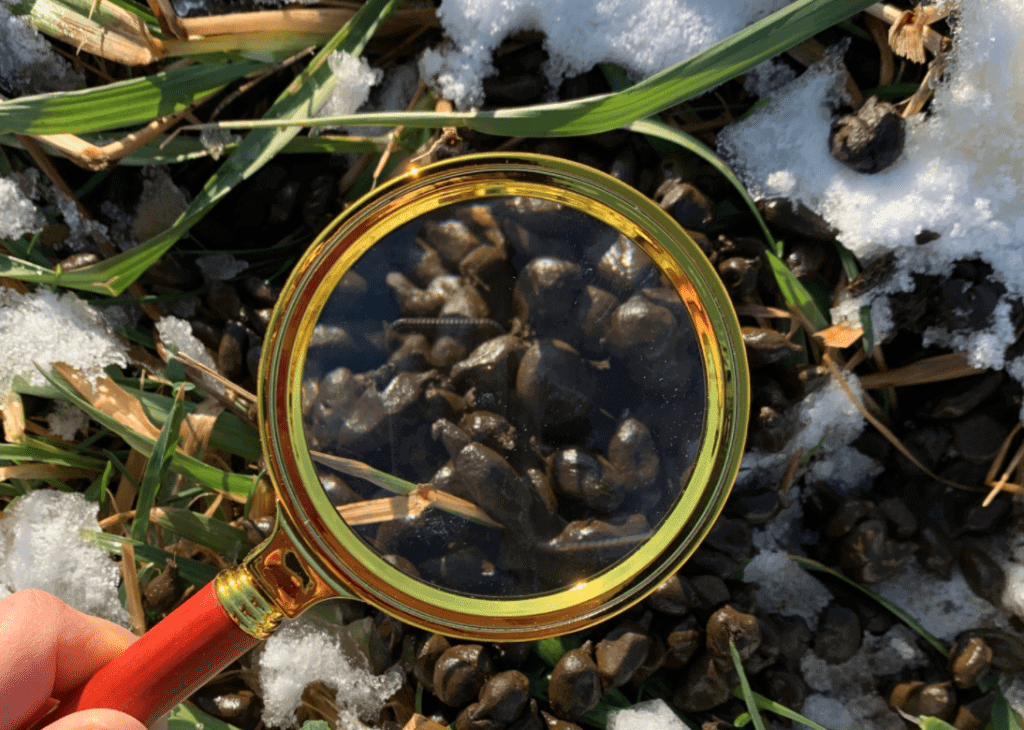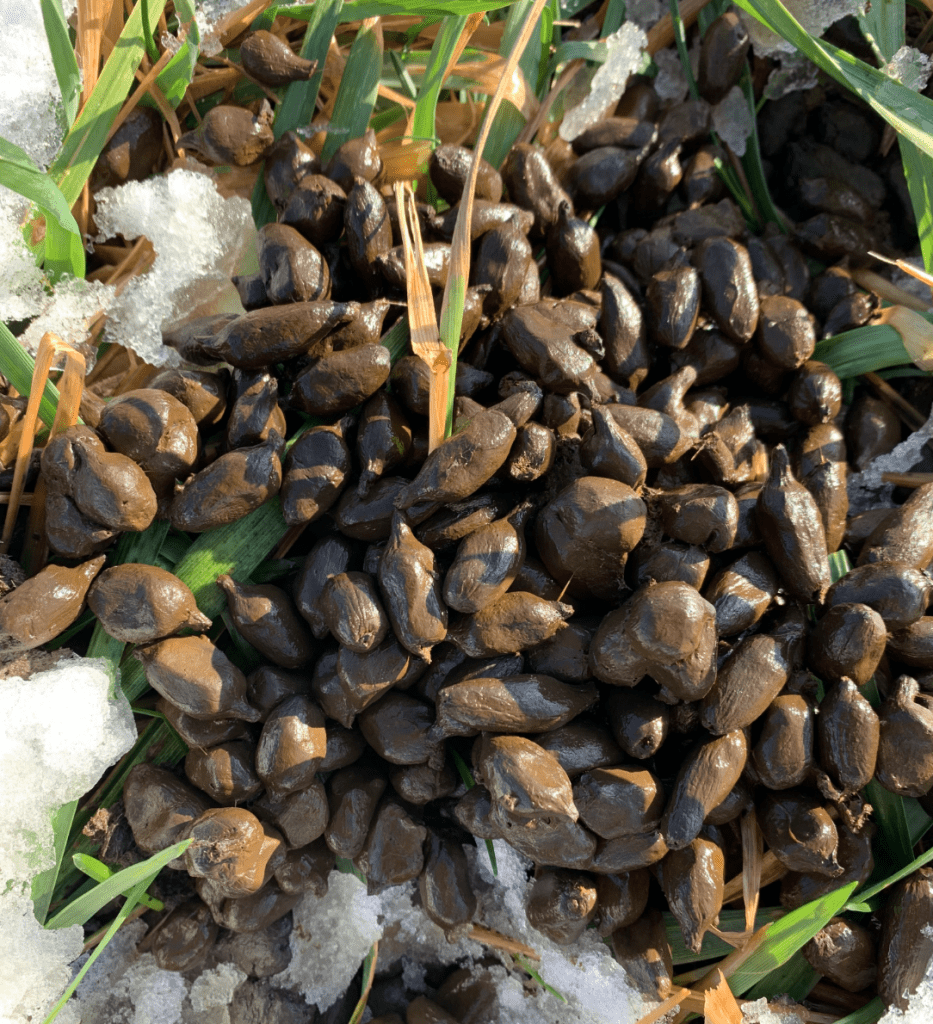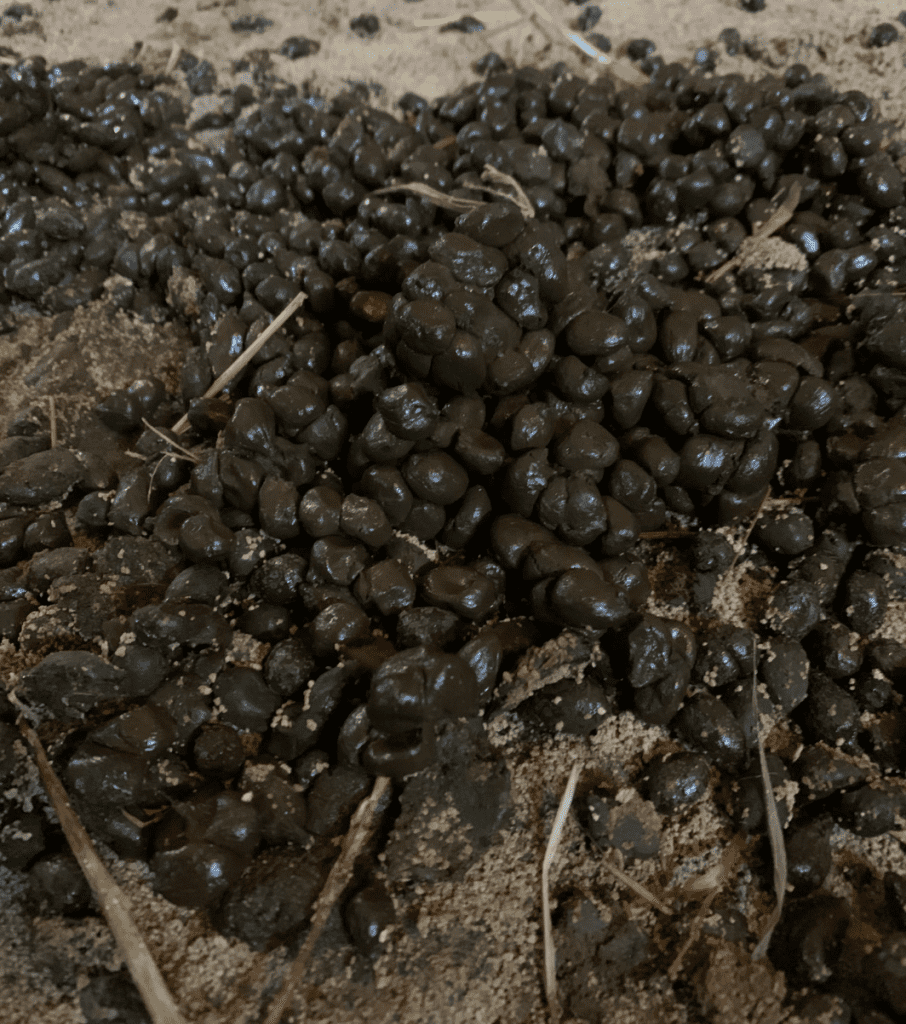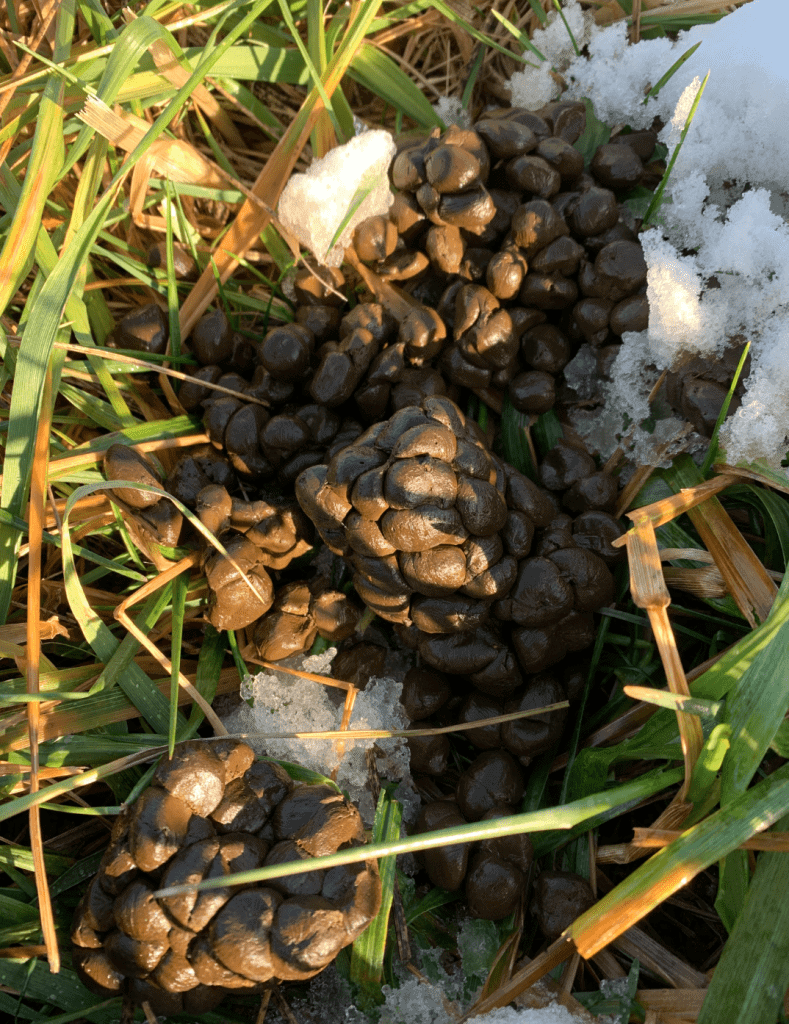
Let’s talk poop: llama and alpaca poop to be exact! If you are providing care to these camelid residents, then you know there’s a lot of it! Thankfully, they tend to leave it all in one communal poop pile. There’s more to poop than you might think. A lot of time, energy, and close observation goes into providing quality care for camelid residents. Putting some of that energy into learning about what is normal versus abnormal llama and alpaca poop can help you provide better care for your residents, and it could even save a life in some instances!
To start, “normal” stools should generally be small brown fecal pellets. Ideally, they will be individual pellets, though some sticking together can be normal so long as it isn’t tightly clumped together and difficult to break apart. This is what you’re likely to see in healthy individuals. Easy to muck without the yuck! However, you are also likely to come across fecal matter that doesn’t look like this. Maybe the color is different, or the consistency, maybe it’s even….slimy. Yup, there is a world of knowledge to be learned about llama and alpaca poop, and this resource is here to introduce you to it!
What Is Normal?
You should always keep in mind that what is considered “normal” for one resident may not be normal for another. While this resource provides a general overview of general signs of health or common poop among llamas and alpacas, every resident is an individual, and you will need to get to know what is normal to the individual in order to provide the best care.



CriaA young llama or alpaca Poop Is Different
This resource focuses on adult alpacas and lamas. Crias often have very different parameters of “normal” from their adult counterparts. For example, a newborn’s first stool (meconium), can be stringy, sticky, or pasty and this is “normal”. Diarrhea can be an indicator of parasites, overfeeding, or other serious health issues. While this resource mentions criasYoung llamas or alpacas, the information does not necessarily apply to crias unless specifically noted. Talk with your veterinarian about what is normal for crias and tuis.
Amount
The amount a llama or alpaca poops will vary and depend on their diet, age, size, and health. A 300-pound llama will produce more poop than a 100-pound llama or alpaca! Learn how often each resident poops so you will be able to identify changes to their pooping habits and know when something may be amiss. They are quite particular about where they poop and will generally use a communal dung pile with everyone in the herd using it. It shouldn’t take a llama or alpaca long to defecate. If they are making frequent trips or are observed at the dump for more than a minute or two during their poop session, this may be indicative of a health issue. Pay attention and note if they are straining while attempting to poop. Straining can also be a sign of an underlying health issue, such as an impaction. Straining with diarrhea may be a sign of internal parasites.
Consistency And Texture
Keeping in mind that “normal” varies between individuals, the consistency of healthy stool should present as firm, multiple individual pellets, sometimes referred to as “beans”. They should fall to the ground in individual pellets, keep their shape, and not be packed tightly together. Some light clumping can be normal. Stools consisting of loose piles, dry and hard fecal matter, or watery diarrhea should be noted and action should be taken where appropriate. Dry, hard stools that may or may not be coated in mucous can be indicative of digestive issues and impaction. Soft, unformed stools may be caused by consuming lush grasses or stress (among other things). Watery or profuse diarrhea is also a cause for serious concern and can be a sign of parasites, systemic disease, or other serious health issues. Both constipation and diarrhea should be taken seriously and your veterinarian should be contacted. Some causes for different consistencies are more serious than others, though it’s important to act quickly and take these signs seriously as they might be life-threatening. In addition to the above, be sure to check your camelid resident’s stools for the presence of parasites, which may be visible in their fecal matter. However, this is not always the case and regular fecal tests should be performed.
Consistency
- Firm: As we already covered, healthy consistency looks like individual pellets that are firm, but easily broken apart, are not clumped together, and lack mucus. Some light clumping isn’t generally cause for concern.
- Hard: Familiarize yourself with the normal consistency of their pellets. Alpaca and llama pellets are drier than the poop of some other resident species, making them firm. This can make ascertaining whether a resident has abnormally hard stools challenging if you are not already familiar with that is normal for them. Fresh pellets should be firm but easily broken apart.
- Soft: There are a number of possible causes of soft, unformed feces. Some of the possible causes are access to and consumption of lush forage, other dietary factors, parasites, or stress.
- Jamlike: Yup, you read that right. Stools may be of a jamlike consistency, possibly accompanied by blood in the stool, which may be referred to as “raspberry jam feces” or “red currant jam feces”. Gross, we know. Residents may pass feces like this if they are suffering from intussusceptions. This is where one part of the intestine slides into another part of the intestines, as a telescope might when closed. A veterinarian should be alerted right away.
- Tarry: Tarry stools may be indicative of bleeding high up in the intestinal tract.
- Watery: Watery stools may be a sign of a heavy parasite load, viral or bacterial infection, systemic disease, or poisoning.
- Pasty: Pasty stools are normal for a newborn’s first poops, but pasty soft stools may also be seen in cryptosporidium infections or in other situations. Speak to your veterinarian if you are unsure or would like more information.
Possible Causes Of Constipation
- Improper/unbalanced diet
- Rapid diet change
- Impactions
- Damage of the digestive system from heavy parasite loads
- Dehydration (A lack of water intake)
- Certain medications
- Dental issues
- Foreign body ingestion
- Acorn poisoning
- Lead or zinc poisoning
- Tumors in the pelvis
Possible Causes Of Diarrhea
- Antibiotics
- Overeating grain
- Rapid changes to diet
- Access to lush, green pastures
- Bacterial infections
- Viral infections
- Bowel diseases
- Ingestion of toxic plants
- Parasites
- Changes to dewormingThe act of medicating an animal to reduce or eliminate internal parasites, either prophylactically or in response to illness. schedules
- Stress
Textures
- Mucous-Covered: This could indicate a number of possible health issues, such as an obstruction, EMAC infection (Eimeria Macusaniensis, a type of coccidia), enteritis (which has numerous causes itself), or even blister beetle poisoning.
- Gritty: This points to the ingestion of sand.
- Dry: Very dry feces could indicate an impaction or constipation.
- Fibrous: Undigested forage could indicate possible digestive or dietary issues and should be discussed with your veterinarian.
Keep An Eye Out For Parasites
It is important to keep an eye out for the presence of parasites in your alpaca and llama residents’ stools. Some parasites may be too small to see in their stool. However, It is normal to see parasites in stool following a de-worming. But remember, just because you don’t see parasites in a llama’s or alpaca’s stool doesn’t mean they don’t have them!
Now that we have covered consistency and texture, let’s move on to color!
Color
Sometimes you may come across a colorful pile that makes you take a second look. The good news is there are many benign reasons for certain colors of poop, though there are some concerning colors that could indicate health issues. Poop can vary in color depending on the llama or alpaca resident’s diet. Brown is a typical color for stools. Let’s look at the rainbow of brown and other possibilities:
- Brown: Shades of brown, particularly dark brown, are generally accepted to be a healthy color for stools but will vary depending on diet and between individuals.
- White Flecks: If you notice white flecks in their stools, these could be eggs from parasites.
- Yellowish-Brown Flecks: If you notice yellowish-brown flecks in their stools, these could be eggs from a lancet fluke.
- Yellowish-Green: Though usually more likely in crias, yellowish-green diarrhea could be a sign of nematodirus battus which may also accompany other viral, bacterial, or coccidial infections.
- Green: Green stools could indicate an intake of large amounts of lush grasses, though dark green feces have also been noted in crias with rotavirus and coronavirus.
- Reddish: If you notice red in their stools or flecks of red it could be blood and you should call your veterinarian. Among other possibilities, this may be seen in coccidiosis infections, coronavirus, or BVD (bovine viral diarrhea). Reddish, clumpy “raspberry jam” stools may indicate intussusception.
- Dark/Black/Tarry: Dark tarry stools could indicate gastrointestinal bleeding high in the intestinal tract.
Okay, we have covered a lot, but we are missing something. We have been avoiding one of the most obvious things about poop: the smell!
Odor
If you care for llamas or alpacas, you probably know the “normal” smell of their poop. However, you may occasionally come across foul-smelling stools that indicate something isn’t quite right. If the stools have a fetid odor, there are a number of reasons why stools may smell strange or downright unpleasant, including enteritis, the presence of parasites, and imbalanced diets. If you notice something off, be sure to talk about it with your veterinarian.
Congratulations! You are now a llama and alpaca poop expert! Well, maybe not an expert, but hopefully this resource has introduced you to helpful information, allowing you to more confidently assess the well-being of your camelid residents.
Infographic
Llama poop by Amber D Barnes
SOURCES:
Chapter 25 – Lactation and Neonatal Care | Llama And Alpaca Care (Contains pictures of crias with congenital defects.)
Alpaca General Medicine Lecture | Healing Springs Animal Hospital
Bovine Viral Diarrhea Virus In Camelids | Washington State University (Non-Compassionate Source)
Veterinary Treatment Of Llamas And Alpacas | Dr Graham R. Duncanson BVSc, Msc (VetGP), DProf, FRCV
Infection Of Llamas With Stored Eimeria Macusaniensis Oocysts Obtained From Guanaco And Alpaca Feces | Parasitology (Non-Compassionate Source)
Dealing with Common Maladies of Camelids | University Of Illinois (Non-Compassionate Source)
Neonatal Diarrhea In llamas And Alpacas | Small Ruminant Research (Camelids are not ruminants) (Non-Compassionate Source)
Medicine And Surgery Of Camelids Third Edition (Non-Compassionate Source)
Non-Compassionate Source?
If a source includes the (Non-Compassionate Source) tag, it means that we do not endorse that particular source’s views about animals, even if some of their insights are valuable from a care perspective. See a more detailed explanation here.








